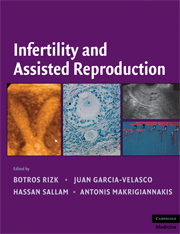Preface
Published online by Cambridge University Press: 04 August 2010
Summary
The readers of this text will encounter a comprehensive and perspicacious view of the discipline of reproductive medicine as revealed by leaders in their respective fields. The editors have assembled a talented group of authors spanning six geographic continents. Some sections of the book – for example, its second section on infertility – are comprehensive enough to stand on their own. The section begins with the evolution of the female and covers in detail the roles of endoscopy, hysteroscopy, and laparoscopy in the management of infertility. The following section deals with ultrasonography of both the female and male, which is followed by a cutting-edge section on the evaluation of the infertile male, beginning with standards of current clinical management and ending with future implications for developing DNA technology. Subsequent sections focus on the physiology of ovulation and the pharmacological agents prescribed by gynecologists today, in addition to a discussion of future pharmacological advances that have the potential to significantly alter treatment strategies. Other clinical areas discussed include the medical management of endometriosis, the relationship of polycystic ovaries to infertility, and the status of premature ovarian failure. A comprehensive assessment on the state of the art in assisted reproduction is detailed in the third section of the book. This is the expertise of one of its editors, Dr. Botros R. M. B. Rizk, so it is perhaps not too surprising that this topic did receive significant attention.
- Type
- Chapter
- Information
- Infertility and Assisted Reproduction , pp. xxi - xxiiPublisher: Cambridge University PressPrint publication year: 2008



